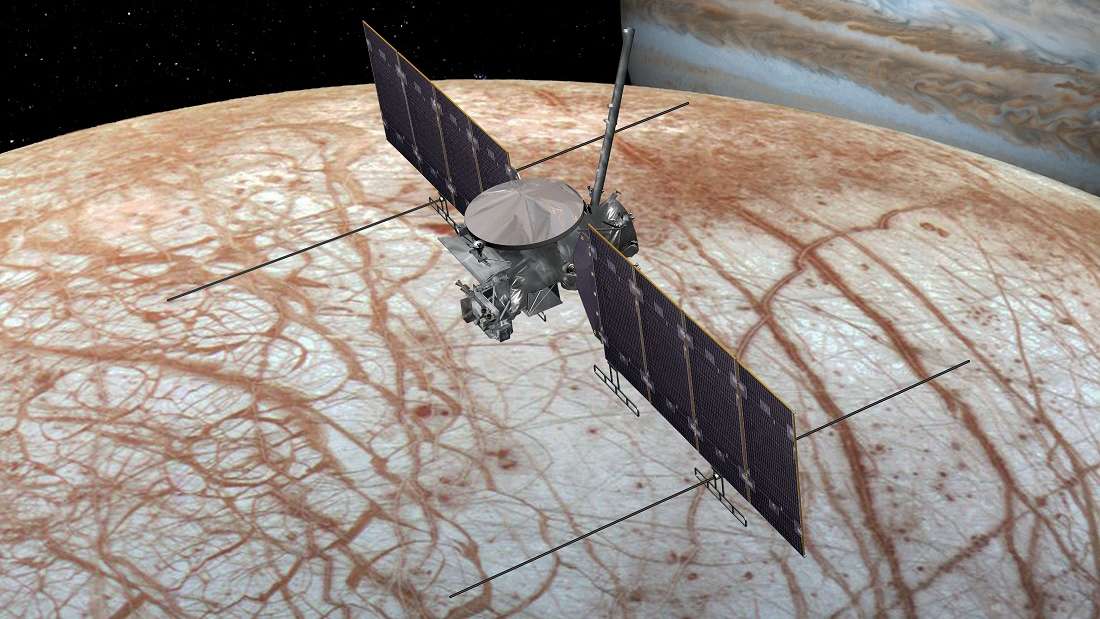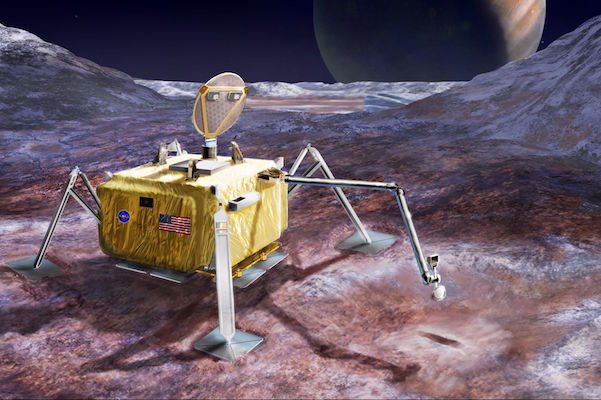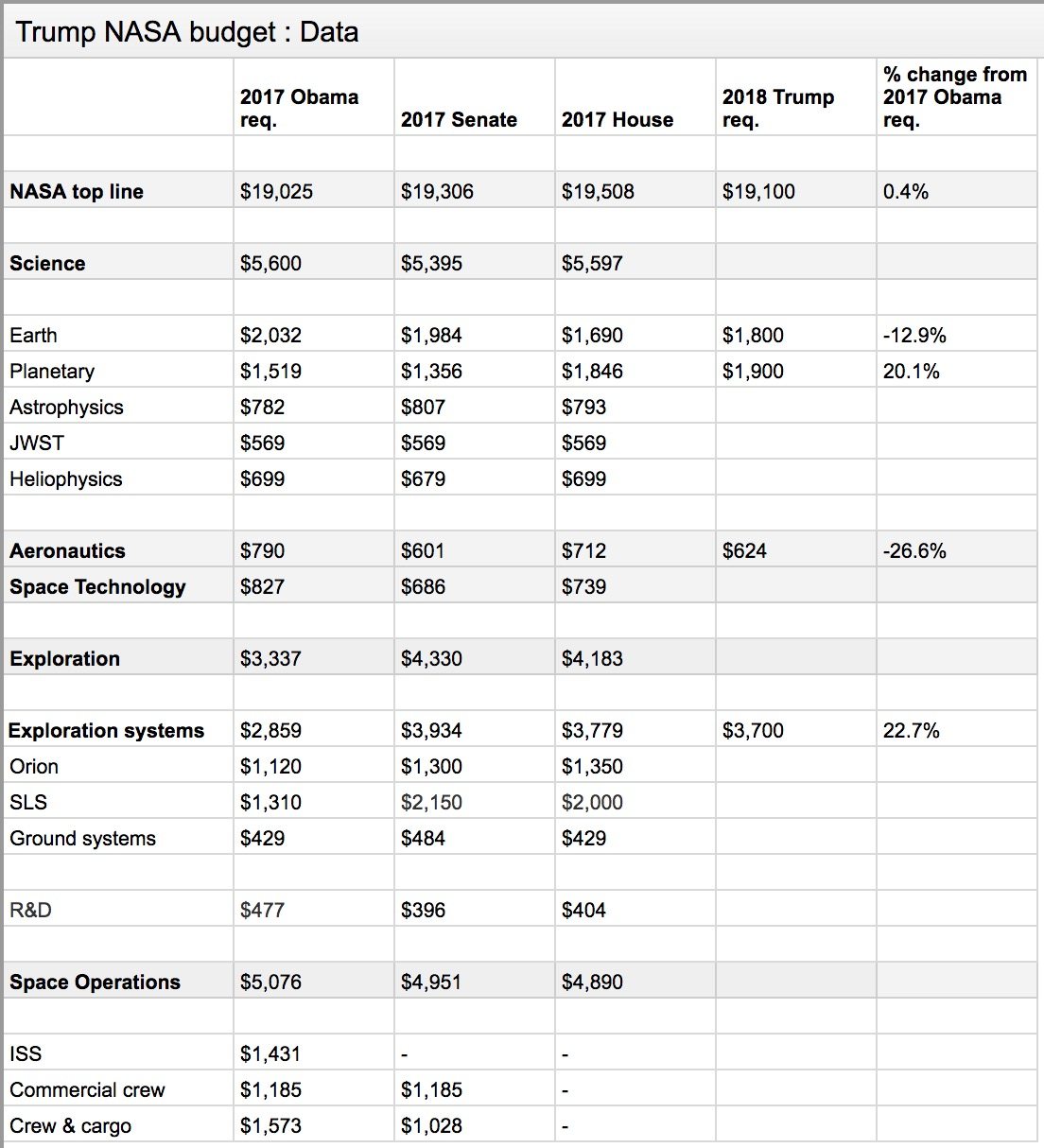Relative to other agencies NASA’s budget cuts under the Trump proposal may not seem dire, but for an agency tasked with “increasing understanding of the universe and our place in it” any cut is unacceptable.
Relative to other agency cuts, the President’s $1.1 trillion dollar proposed 2018 budget granting NASA $19.1 billion, a 0.8% decrease, may not seem dire. President Trump’s proposed budget, released Thursday, slashes billions from a broad array of programs, including funding for environmental protection (31% cut), agriculture, labor, justice, housing, education, health & human services, energy, transportation, and the arts. The budget will impact millions, including families, children, students, the elderly, the disabled, cutting or restricting services and programs that are already stressed. Critics were quick to respond on social media.
So cutting what some may deem unnecessary, or in the least, not a priority, can include space exploration. In a world where the U.S. military spent $20 billion on air conditioning tents and temporary structures, more than NASA’s entire annual budget, Americans may respond with “meh”. In fact, many consider NASA having dodged a bullet with a budget that is a 0.4 percent increase from President Obama’s 2017 proposal. Nevertheless, for an agency that “is responsible for increasing understanding of the universe and our place in it, advancing America’s world-leading aerospace technology, inspiring the Nation, and opening the space frontier,” any cut to NASA that sets back that mission is, in our opinion, too much.
This week NASA’s acting Administrator Robert Lightfoot issued a statement addressing the proposed budget’s impact on its operations. According to Lightfoot, “The President mentioned in his speech to both houses of Congress that, ‘American footprints on distant worlds are not too big a dream.’ NASA is already working toward that goal, and we look forward to exciting achievements that this budget will help us reach.”
Lightfoot ends his statement, “As with any budget, we have greater aspirations than we have means, but this blueprint provides us with considerable resources to carry out our mission, and I know we will make this nation proud.”
While appearing chipper, a deeper look may suggest otherwise.

While NASA reports that the budget “reinvigorates robotic exploration of the Solar System by providing $1.9 billion for the Planetary Science program,” funds for the anticipated Europa moon landing would be cut.
Europa is a moon of Jupiter covered in a sheet of ice. Europa Report is a 2013 sci-fi film that had a budget of less than $10 million, received generally positive reviews, and scored an 80% “Certified Fresh” rating from Rotten Tomatoes. Europa the icy moon, was discovered by Galileo and is the sixth largest moon in the solar system. But here’s the kicker – it has a “tenuous” atmosphere composed primarily of oxygen, and a salty liquid water ocean beneath its surface that could conceivably harbor extraterrestrial life.
NASA’s Europa Clipper is a plan for a satellite launch in the 2020s to explore the moon. The spacecraft will arrive at Jupiter after a multi-year journey, and orbit it every two weeks for a series of 45 close flybys of Europa. The Europa Lander (article main image) is a proposed landing that would have gone on the first or following missions. The mission would include an effort to determine if the ocean under the ice is habitable. Under the Trump budget proposal, this has been nixed. Instead, the budget only allows for a flyby.
The new budget essentially forces a redistribution of NASA’s budget. Funding for the Europa Clipper would come as part of a 20.1 percent increase for NASA’s Planetary Science division.

Another program facing cuts is the Asteroid Redirect Mission, a plan to place asteroids into orbit around the moon, where they could be studied by astronauts. The mission would also “demonstrate planetary defense techniques to deflect dangerous asteroids and protect Earth if needed in the future.” Hint: Armageddon, a film with a $140 million budget.
Even more interesting, according to NASA, “most importantly, NASA’s Asteroid Redirect Mission will greatly advance NASA’s human path to Mars, testing the capabilities needed for a crewed mission to the Red Planet in the 2030s.” This would finally answer Matt Damon’s great question, can we grow potatoes on Mars?
The program has faced prolonged scrutiny from Congress. NASA appears to be taking this cut in good spirits. According to acting Administrator Lightfoot:
“We remain committed to the next human missions to deep space, but we will not pursue the Asteroid Redirect Mission (ARM) with this budget. This doesn’t mean, however, that the hard work of the teams already working on ARM will be lost. We will continue the solar electric propulsion efforts benefitting from those developments for future in space transportation initiatives. I have had personal involvement with this team and their progress for the past few years, and am I extremely proud of their efforts to advance this mission.”
Coming back to Earth, the budget proposal would not affect NASA’s commercial partnerships, including plans by SpaceX and Boeing to send astronauts into low orbit. Inside the atmosphere, NASA’s Aeronautics program, for developing aircraft, will drop by 26.6 percent, and environmental science studies will be cut. In cyberspace, NASA is confident that the budget “strengthens NASA’s cybersecurity capabilities, safeguarding critical systems and data.”
But by far the worse budget cut is to the Office of Education ($115 million). It will disappear entirely. Over the years OE has provided countless education projects, internships, scholarships and fellowships, for America’s young future scientists. There was even an Astro Camp! Many also wonder what will happen to NASA Kid’s Club, where, in addition to educational games, you can find out who is on the International Space Station.
According to NASA, the dissolution of OE will result in “a more focused education effort through NASA’s Science Mission Directorate.” NASA states that the department was performing functions “duplicative of other parts of the agency” anyway.
NASA acting Administrator Robert Lightfoot addressed this dramatic cut optimistically in his statement:
“While this budget no longer funds a formal Office of Education, NASA will continue to inspire the next generation through our missions and channel education efforts in a more focused way through the robust portfolio of our Science Mission Directorate. We will also continue to use every opportunity to support the next generation through engagement in our missions and the many ways that our work encourages the public to discover more.”
Things like this would be gone:
Are you in 10th or 11th grade? Interested in a STEM career? Applications for 2017 NASA SEES Internships due April 4! https://t.co/Uh2nro5wS3 pic.twitter.com/qYBlrU4fD7
— NASA STEM (@NASASTEM) March 14, 2017
What was your reaction when you received the offer to be a NASA intern? Michael was only a little excited. #internships #NASA pic.twitter.com/AAkZBd9oY8
— NASA Internships (@NASAInterns) March 14, 2017
A helpful chart from the Planetary Society gives a more detailed view.
Overall, the proposed budget seems to have NASA’s social media team feeling out of this world.
#AmericasBudget lets us continue work to send humans deeper into space, innovate aeronautics & explore our universe: https://t.co/ANvLmykAw3 pic.twitter.com/5MHT0pZXb0
— NASA (@NASA) March 16, 2017
Apart from NASA, President Trump’s proposed budget seeks spending increases for defense (to $639 billion), Homeland Security (harden the southern border, vis-à-vis, the border wall), and the Department of Veterans Affairs. It proposes numerous cuts to a broad array of programs, including, environmental protection, foreign aid and U.N. funding, agriculture, labor, justice, housing, education, health & human services, energy, transportation, and funding for the arts. Both the House and Senate will weigh in, propose changes, and forward a final version to President Trump for signature.
Below is a summary of key provisions:
Spending Increases:
- $54 billion total increase in defense spending, raising the total defense budget to $639 billion. This 10% increase would escalate fighting against ISIS and would include $30 billion for the Department of Defense, covering procurement for F-35 fighter aircraft and drone systems. Defense hawks, including Sen. John McCain, argue the increase is not enough, and that $37 billion more would be required.
- $3 billion for the Department of Homeland Security, which would go toward starting the wall, and building detention facilities. $1.5 billion in 2017 would go to the Mexican border wall to launch pilot projects, and a further $2.6 billion in fiscal 2018.
- $4.4 billion for the Department of Veterans Affairs, easing access to care outside of V.A. facilities, investing in I.T. infrastructure, and assisting the claims department.
Decreases:
- $2.6 billion in cuts to the EPA, over 31 percent, focusing on cutting climate change and clean power related programs. The budget would slightly increase, $4 million, clean water programs.
- $10.9 billion from the State Department, over 28 percent, including U.N. funding, development banks, and foreign aid, but excluding the $3.1 billion in aid to Israel.
- $4.7 billion from the Agriculture Department, reducing loans and grants for wastewater, cutting staff in county offices and stopping assistance to farmers in donating crops to overseas aid.
- $2.5 billion from Labor.
- $4 billion from Justice, reducing prison construction, and expenditures on non-discressionary programs like compensation for victims of crime, while increasing F.B.I. and immigration judge expenditures.
- $4.3 billion in cuts to Housing, cutting community development grants that target poverty.
- $12.6 billion from Health and Human Services, cutting services for low income Americans, and medical research.
- $9.6 billion from Education, including before and after school programs, work study, and financial aid for college.
- $1.7 billion from the Energy Department, reducing renewable energy research, while increasing funding for nuclear weapons.
- $2.4 billion from Transportation, which would start privatizing air traffic control, and cuts to Amtrak.
- Ending funding to 19 independent content producers that make public broadcasting, the arts and regional issues from Alaska to Appalachia. This would include the Corporation for Public Broadcasting, that provides funding to NPR and PBS, and the National Endowment for the Arts and the National Endowment for the Humanities.
Full text of the budget here.
LIMA CHARLIE NEWS
Lima Charlie provides global news, insight & analysis by military veterans and service members Worldwide.
For up-to-date news, please follow us on twitter at @LimaCharlieNews




![Image GailForce to Space Force: 'Make it so' - the Space Force debate continues [Lima Charlie News]](https://limacharlienews.com/wp-content/uploads/2019/05/Space-Force-01-480x384.png)
![Image Imagine a Global Space Community ... The Space Foundation Can [Lima Charlie News][Graphic by Anthony A. LoPresti]](https://limacharlienews.com/wp-content/uploads/2019/03/Space-Foundation-Space-Symposium-Lima-Charlie-News-480x384.png)
![Image Gaming industry inspired supercomputer to help scientists study mysterious radio emissions from space [Lima Charlie News]](https://limacharlienews.com/wp-content/uploads/2018/01/Gaming-industry-inspired-supercomputer-to-help-scientists-study-mysterious-radio-emissions-from-space-480x384.jpg)



![Image Memorial Day may soon be a remembrance of democracy and those who had the courage to defend it [Lima Charlie News]](https://limacharlienews.com/wp-content/uploads/2018/05/Memorial-Day-may-soon-be-a-remembrance-of-democracy-and-those-who-had-the-courage-to-defend-it-Lima-Charlie-News-480x384.png)
![The Mind of Bolton - AUMF and the New Iran War [Lima Charlie News]](https://limacharlienews.com/wp-content/uploads/2019/05/Inside-the-mind-of-Bolton-Lima-Charlie-News-main-01-480x384.png)
![Image GailForce to Space Force: 'Make it so' - the Space Force debate continues [Lima Charlie News]](https://limacharlienews.com/wp-content/uploads/2019/05/Space-Force-01-150x100.png)
![Image Imagine a Global Space Community ... The Space Foundation Can [Lima Charlie News][Graphic by Anthony A. LoPresti]](https://limacharlienews.com/wp-content/uploads/2019/03/Space-Foundation-Space-Symposium-Lima-Charlie-News-150x100.png)